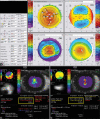Current concepts in the management of cataract with keratoconus
- PMID: 38389251
- PMCID: PMC11149527
- DOI: 10.4103/IJO.IJO_1241_23
Current concepts in the management of cataract with keratoconus
Abstract
This review analyzed all pertinent articles on keratoconus (KCN) and cataract surgery. It covers preoperative planning, intraoperative considerations, and postoperative management, with the aim of providing a simplified overview of treating such patients. Preoperatively, the use of corneal cross-linking, intrastromal corneal ring segments, and topo-guided corneal treatments can help stabilize the cornea and improve the accuracy of biometric measurements. It is important to consider the advantages and disadvantages of traditional techniques such as penetrating keratoplasty and deep anterior lamellar keratoplasty, as well as newer stromal augmentation techniques, to choose the most appropriate surgical approach. Obtaining reliable measurements can be difficult, especially in the advanced stages of the disease. The choice between toric and monofocal intraocular lenses (IOLs) should be carefully evaluated. Monofocal IOLs are a better choice in patients with advanced disease, and toric lenses can be used in mild and stable KCN. Intraoperatively, the use of a rigid gas permeable (RGP) lens can overcome the challenge of image distortion and loss of visual perspective. Postoperatively, patients may need updated RGP or scleral lenses to correct the corneal irregular astigmatism. A thorough preoperative planning is crucial for good surgical outcomes, and patients need to be informed regarding potential postoperative surprises. In conclusion, managing cataracts in KCN patients presents a range of challenges, and a comprehensive approach is essential to achieve favorable surgical outcomes.
Copyright © 2024 Copyright: © 2024 Indian Journal of Ophthalmology.
Conflict of interest statement
There are no conflicts of interest.
Figures




Similar articles
-
Cataract surgery in Keratoconus revisited - An update on preoperative and intraoperative considerations and postoperative outcomes.Semin Ophthalmol. 2023 Jan;38(1):57-64. doi: 10.1080/08820538.2022.2112702. Epub 2022 Aug 22. Semin Ophthalmol. 2023. PMID: 35996343 Review.
-
Cataract surgery in eyes with keratoconus: a review of the current literature.Curr Opin Ophthalmol. 2018 Jan;29(1):75-80. doi: 10.1097/ICU.0000000000000440. Curr Opin Ophthalmol. 2018. PMID: 28961565 Review.
-
[Intraocular correction of ametropia in patients with keratoconus].Vestn Oftalmol. 2020;136(5):123-128. doi: 10.17116/oftalma2020136051123. Vestn Oftalmol. 2020. PMID: 33056973 Review. Russian.
-
Changes in astigmatism and corneal higher-order aberrations after phacoemulsification with toric intraocular lens implantation for mild keratoconus with cataract.Jpn J Ophthalmol. 2016 Jul;60(4):302-8. doi: 10.1007/s10384-016-0449-x. Epub 2016 May 10. Jpn J Ophthalmol. 2016. PMID: 27165708
-
Toric IOL implantation in a patient with keratoconus and previous penetrating keratoplasty: a case report and review of literature.BMC Ophthalmol. 2018 Aug 29;18(1):215. doi: 10.1186/s12886-018-0895-y. BMC Ophthalmol. 2018. PMID: 30157798 Free PMC article. Review.
Cited by
-
Biometry and keratometry measurements after intracorneal ring segment implantation in keratoconus patients: a pilot comparison between Pentacam AXL and IOL Master 700.BMC Ophthalmol. 2025 Feb 18;25(1):80. doi: 10.1186/s12886-025-03914-2. BMC Ophthalmol. 2025. PMID: 39966768 Free PMC article.
-
Studying the effect of keratoconus severity on the accuracy of intraocular lens power calculation using newer keratoconus-specific formulas.BMC Ophthalmol. 2025 Apr 17;25(1):219. doi: 10.1186/s12886-025-04040-9. BMC Ophthalmol. 2025. PMID: 40247207 Free PMC article.
References
-
- Singh C, Joshi VP. Cataract surgery in Keratoconus revisited-An update on preoperative and intraoperative considerations and postoperative outcomes. Semin Ophthalmol. 2023;38:57–64. - PubMed
-
- Thebpatiphat N, Hammersmith KM, Rapuano CJ, Ayres BD, Cohen EJ. Cataract surgery in keratoconus. Eye Contact Lens. 2007;33:244–6. - PubMed
-
- Mukesh BN, Le A, Dimitrov PN, Ahmed S, Taylor HR, McCarty CA. Development of cataract and associated risk factors: The Visual Impairment Project. Arch Ophthalmol. 2006;124:79–85. - PubMed
-
- Leccisotti A. Refractive lens exchange in keratoconus. J Cataract Refract Surg. 2006;32:742–6. - PubMed
-
- Hashemi H, Heydarian S, Hooshmand E, Saatchi M, Yekta A, Aghamirsalim M, et al. The Prevalence and risk factors for keratoconus: A systematic review and meta-analysis. Cornea. 2020;39:263–70. - PubMed
Publication types
MeSH terms
LinkOut - more resources
Full Text Sources
Medical

